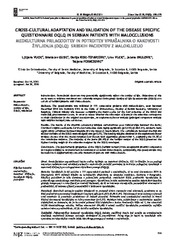Приказ основних података о документу
Cross-cultural adaptation and validation of the disease specific questionnaire oqlq in Serbian patients with malocclusions
| dc.creator | Vučić, Ljiljana | |
| dc.creator | Glišić, Branislav | |
| dc.creator | Kisić-Tepavčević, Darija | |
| dc.creator | Vučić, Uroš | |
| dc.creator | Drulović, Jelena | |
| dc.creator | Pekmezović, Tatjana | |
| dc.date.accessioned | 2020-07-02T13:02:18Z | |
| dc.date.available | 2020-07-02T13:02:18Z | |
| dc.date.issued | 2016 | |
| dc.identifier.issn | 0351-0026 | |
| dc.identifier.uri | https://smile.stomf.bg.ac.rs/handle/123456789/2075 | |
| dc.description.abstract | Introduction. Dentofacial disorders may potentially significantly affect the quality of life. Objectives of this study were to validate translated and culturally adapted Orthognatic Quality of Life Questionnaire (OQLQ) on a cohort of Serbian patients with malocclusions. Methods. The questionnaire was validated in 111 consecutive patients with malocclusions, seen between December 2014 and February 2015 at the Clinic of Orthodontics, Faculty of Dental Medicine, University of Belgrade. Clinical validity was assessed comparing the mean scores for the four subscales of the OQLQ and mean PAR pre-treatment score. In order to assess whether the allocation of items in the subscales corresponds to their distribution in the original questionnaire, an exploratory factor analysis (principal component analysis with varimax rotation) was conducted. Results. The results of the internal consistency analysis demonstrated good relationships between the items; Cronbach's alpha coefficients for the four subscales were highly significant (p lt 0.001) (0.88-0.91). All items were significantly correlated between baseline and the retest (6 weeks after). The correlations between the PAR and all four domains of the OQLQ were all significant (p lt 0.01). The loading weights obtained in the exploratory factor analysis showed that this model revealed four factors with eigenvalue greater than 1, explaining the 64.0% of the cumulative variance. The majority of the items (86.4%) in the Serbian version of the OQLQ presented the highest loading weight in the subscales assigned by the OQLQ developer. Conclusions. The psychometric properties of the OQLQ (Serbian version) have exceptional internal consistency and reproducibility as an instrument for evaluation of dental malocclusions. Additionally, this questionnaire may be useful as a supplementary outcome measure in persons with malocclusions. | en |
| dc.publisher | Inst Public Health Republic Slovenia, Ljubljana | |
| dc.relation | info:eu-repo/grantAgreement/MESTD/Basic Research (BR or ON)/175031/RS// | |
| dc.relation | info:eu-repo/grantAgreement/MESTD/Basic Research (BR or ON)/175087/RS// | |
| dc.rights | openAccess | |
| dc.source | Zdravstveno varstvo | |
| dc.subject | malocclusions | en |
| dc.subject | quality of life | en |
| dc.subject | OQLQ | en |
| dc.subject | validation | en |
| dc.title | Cross-cultural adaptation and validation of the disease specific questionnaire oqlq in Serbian patients with malocclusions | en |
| dc.type | article | |
| dc.rights.license | ARR | |
| dcterms.abstract | Пекмезовић, Татјана; Друловић, Јелена; Вучић, Урош; Глишић, Бранислав; Вучић, Љиљана; Кисић-Тепавчевић, Дарија; | |
| dc.citation.volume | 55 | |
| dc.citation.issue | 3 | |
| dc.citation.spage | 166 | |
| dc.citation.epage | 173 | |
| dc.citation.other | 55(3): 166-173 | |
| dc.citation.rank | M23 | |
| dc.identifier.wos | 000379312000003 | |
| dc.identifier.doi | 10.1515/sjph-2016-0021 | |
| dc.identifier.pmid | 27703535 | |
| dc.identifier.scopus | 2-s2.0-84978429666 | |
| dc.identifier.fulltext | https://smile.stomf.bg.ac.rs/bitstream/id/703/2070.pdf | |
| dc.type.version | publishedVersion |


